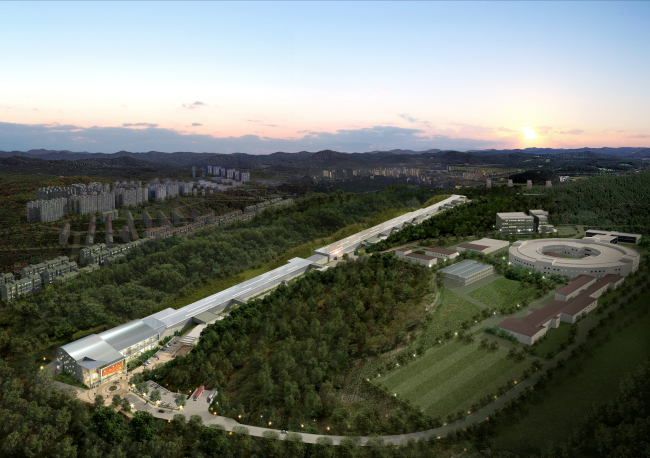Korea will build a facility for a next-generation light source that creates high-energy X-rays, 10 billion times brighter than its current most powerful source.
The government had a groundbreaking ceremony on Thursday to build a “fourth-generation synchrotron radiation” facility in Pohang, North Gyeongsang Province.
A synchrotron accelerates particles such as electrons to extremely high energies, creating an electron beam that travels at almost the speed of light. It then uses this beam to generate X-rays, typically for use in experiments that look at things on a very small scale or time frame.
 |
An aerial view of where the fourth-generation synchrotron facility will be constructed in Pohang, North Gyeongsang Province. (POSTECH) |
The construction project is a collaboration between the Ministry of Science, ICT and Future Planning and Pohang University of Science and Technology.
Under the project, the new generation synchrotron will be constructed on 102,700 square meters of land in Pohang with a total budget of 426 billion won ($390 million).
The new light source uses X-ray radiation at a much greater intensity than the previous synchrotron, allowing researchers to study molecules in real time and follow chemical reactions as they happen.
When construction is completed in 2014, Korea will become the third country after the U.S. and Japan to have such an advanced facility, according to the ministry.
POSTECH, which has the country’s first synchrotron light accelerator, completed in 1994, has concentrated on high-energy physics and synchrotron radiation research with its Pohang Accelerator Laboratory.
Currently, more than 1,000 experiments are conducted at the existing synchrotron lab in a year, producing an average of 400 Science Citation Index papers annually, according to the university.
Officials said the new light source would allow researchers to conduct revolutionary experiments in a range of scientific fields, including biology, chemistry and engineering.
“The fourth-generation synchrotron will allow us to conduct a wide range of experiments that are not possible with the current synchrotron,” said Ko In-soo, head of the project team.
“We can carry out experiments to find breakthroughs,” he added.
By Oh Kyu-wook (
596story@heraldcorp.com)







![[Weekender] Korea's traditional sauce culture gains global recognition](http://res.heraldm.com/phpwas/restmb_idxmake.php?idx=644&simg=/content/image/2024/11/21/20241121050153_0.jpg)
